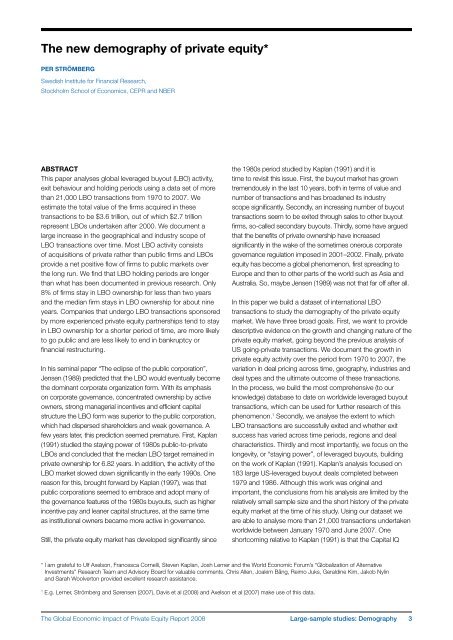The Global Economic Impact of Private Equity Report 2008 - World ...
The Global Economic Impact of Private Equity Report 2008 - World ...
The Global Economic Impact of Private Equity Report 2008 - World ...
- No tags were found...
Create successful ePaper yourself
Turn your PDF publications into a flip-book with our unique Google optimized e-Paper software.
<strong>The</strong> new demography <strong>of</strong> private equity*Per StrömbergSwedish Institute for Financial Research,Stockholm School <strong>of</strong> <strong>Economic</strong>s, CEPR and NBERAbstractThis paper analyses global leveraged buyout (LBO) activity,exit behaviour and holding periods using a data set <strong>of</strong> morethan 21,000 LBO transactions from 1970 to 2007. Weestimate the total value <strong>of</strong> the firms acquired in thesetransactions to be $3.6 trillion, out <strong>of</strong> which $2.7 trillionrepresent LBOs undertaken after 2000. We document alarge increase in the geographical and industry scope <strong>of</strong>LBO transactions over time. Most LBO activity consists<strong>of</strong> acquisitions <strong>of</strong> private rather than public firms and LBOsprovide a net positive flow <strong>of</strong> firms to public markets overthe long run. We find that LBO holding periods are longerthan what has been documented in previous research. Only8% <strong>of</strong> firms stay in LBO ownership for less than two yearsand the median firm stays in LBO ownership for about nineyears. Companies that undergo LBO transactions sponsoredby more experienced private equity partnerships tend to stayin LBO ownership for a shorter period <strong>of</strong> time, are more likelyto go public and are less likely to end in bankruptcy orfinancial restructuring.In his seminal paper “<strong>The</strong> eclipse <strong>of</strong> the public corporation”,Jensen (1989) predicted that the LBO would eventually becomethe dominant corporate organization form. With its emphasison corporate governance, concentrated ownership by activeowners, strong managerial incentives and efficient capitalstructure the LBO form was superior to the public corporation,which had dispersed shareholders and weak governance. Afew years later, this prediction seemed premature. First, Kaplan(1991) studied the staying power <strong>of</strong> 1980s public-to-privateLBOs and concluded that the median LBO target remained inprivate ownership for 6.82 years. In addition, the activity <strong>of</strong> theLBO market slowed down significantly in the early 1990s. Onereason for this, brought forward by Kaplan (1997), was thatpublic corporations seemed to embrace and adopt many <strong>of</strong>the governance features <strong>of</strong> the 1980s buyouts, such as higherincentive pay and leaner capital structures, at the same timeas institutional owners became more active in governance.Still, the private equity market has developed significantly sincethe 1980s period studied by Kaplan (1991) and it istime to revisit this issue. First, the buyout market has growntremendously in the last 10 years, both in terms <strong>of</strong> value andnumber <strong>of</strong> transactions and has broadened its industryscope significantly. Secondly, an increasing number <strong>of</strong> buyouttransactions seem to be exited through sales to other buyoutfirms, so-called secondary buyouts. Thirdly, some have arguedthat the benefits <strong>of</strong> private ownership have increasedsignificantly in the wake <strong>of</strong> the sometimes onerous corporategovernance regulation imposed in 2001–2002. Finally, privateequity has become a global phenomenon, first spreading toEurope and then to other parts <strong>of</strong> the world such as Asia andAustralia. So, maybe Jensen (1989) was not that far <strong>of</strong>f after all.In this paper we build a dataset <strong>of</strong> international LBOtransactions to study the demography <strong>of</strong> the private equitymarket. We have three broad goals. First, we want to providedescriptive evidence on the growth and changing nature <strong>of</strong> theprivate equity market, going beyond the previous analysis <strong>of</strong>US going-private transactions. We document the growth inprivate equity activity over the period from 1970 to 2007, thevariation in deal pricing across time, geography, industries anddeal types and the ultimate outcome <strong>of</strong> these transactions.In the process, we build the most comprehensive (to ourknowledge) database to date on worldwide leveraged buyouttransactions, which can be used for further research <strong>of</strong> thisphenomenon. 1 Secondly, we analyse the extent to whichLBO transactions are successfully exited and whether exitsuccess has varied across time periods, regions and dealcharacteristics. Thirdly and most importantly, we focus on thelongevity, or “staying power”, <strong>of</strong> leveraged buyouts, buildingon the work <strong>of</strong> Kaplan (1991). Kaplan’s analysis focused on183 large US-leveraged buyout deals completed between1979 and 1986. Although this work was original andimportant, the conclusions from his analysis are limited by therelatively small sample size and the short history <strong>of</strong> the privateequity market at the time <strong>of</strong> his study. Using our dataset weare able to analyse more than 21,000 transactions undertakenworldwide between January 1970 and June 2007. Oneshortcoming relative to Kaplan (1991) is that the Capital IQ* I am grateful to Ulf Axelson, Francesca Cornelli, Steven Kaplan, Josh Lerner and the <strong>World</strong> <strong>Economic</strong> Forum’s “<strong>Global</strong>ization <strong>of</strong> AlternativeInvestments” Research Team and Advisory Board for valuable comments. Chris Allen, Joakim Bång, Reimo Juks, Geraldine Kim, Jakob Nylinand Sarah Woolverton provided excellent research assistance.1E.g. Lerner, Strömberg and Sørensen (2007), Davis et al (<strong>2008</strong>) and Axelson et al (2007) make use <strong>of</strong> this data.<strong>The</strong> <strong>Global</strong> <strong>Economic</strong> <strong>Impact</strong> <strong>of</strong> <strong>Private</strong> <strong>Equity</strong> <strong>Report</strong> <strong>2008</strong>Large-sample studies: Demography















